India is primarily an agrarian economy. Agriculture remains the chief source of income for the majority of the rural households. India’s economy is also heavily dependent on the agricultural produce that constitutes a major portion of its exports as well. However, despite mounting importance of agriculture, the sector is still far behind in technological advancements. Crop failure due to adverse weather conditions and uncontrolled pests issues have been the key contributors to this scenario. Moreover, Indian farmers are even now dependent on monsoon rains for irrigation and use age-old methods for other farming practices. Hence, the quality and quantity of agricultural produce is sometimes compromised in spite of the relentless efforts of farmers.
Fortunately, there is hope. What if crop failure could be detected in advance, and necessary steps could be taken? Can there be a juxtaposition of traditional farming methods and innovative solutions like agri-drones to tackle the problems ailing the agricultural sector in India? Can drones become major players in the area of crop surveillance, thus leading to better chances of failure mitigation? We will explore all these opportunities in this article and try to see what the future has in store.
Drones and the Indian agriculture industry
Drones are uncrewed aerial vehicles (also known as UAVs), which are used for surveillance in various industries. Till now, they were primarily used by companies working in industrial sectors such as mining and construction, army, and hobbyists.
But now, drone technology is increasingly available for use in various sectors of agriculture as well. Though the technology is still nascent in India, many companies are trying so that it is easily available to Indian farmers and ready to be used to increase efficiency in agricultural production.
The Use of Agri-Drones is on the Rise
A lot of drone-based agricultural projects are undergoing in India. Consider the following real-life scenarios:
- On 26th January 2022, the Government of India has also released a certification scheme for agricultural drones, which can now carry a payload that does not include chemicals or other liquids used in spraying drones. Such liquids may be sprayed by following applicable rules and regulations.
- On 23rd January 2022, to promote the use of drones for agricultural purposes and reduce the labour burden on the farmers, the government of India has recently offered, a 100% subsidy or 10 lakhs, whichever is less, up to March 2023 to the Farm Machinery Training and Testing Institutes, ICAR Institutes, Krishi Vigyan Kendras & State Agriculture Universities.
Additionally, a contingency fund of Rs.6000/hectare will also be set up for hiring Drones from Custom Hiring Centres (CHC). The subsidy and the contingency funds will help the farmers access and adopt this extensive technology at an inexpensive price.
- On 16th November 2020, the Indian government granted the International Crops Research Institute (ICRISAT), to use of drones for agricultural research activities. With this move, the government hopes to encourage budding researchers and entrepreneurs to look at budget-friendly drone solutions for more than 6.6 lakh Indian villages.
Though the usage will be conditional, yet it is a revolutionary step. Amber Dubey, Joint Secretary, Ministry of Civil Aviation, emphasized that drones are poised to play a big role in agriculture, especially in areas including precision agriculture, improvement in crop yield, and locust control.
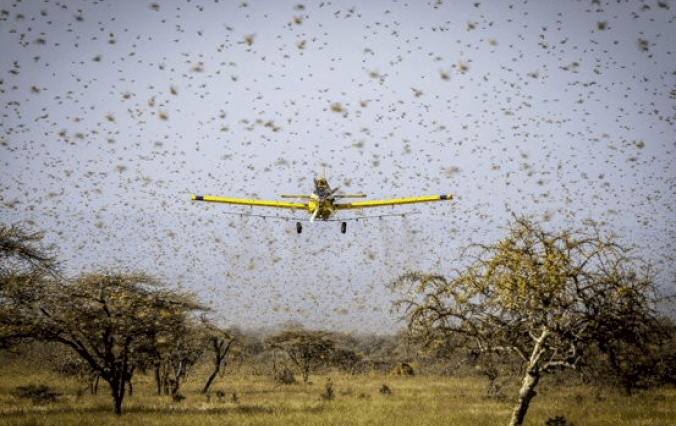
Advantages of Using Drones in Agriculture
The use of drone technology in agriculture is here to stay.
According to recent research, the global drone market within agriculture would grow at 35.9% CAGR and reach $5.7 billion by 2025.
The use of drone technology in agriculture is here to stay. This emerging technology can help reduce time and increase the efficiencies of the farmers. The use of drones in the agricultural sector is only expected to rise as the industry matures, and so it is good to know how to use this technology judiciously.
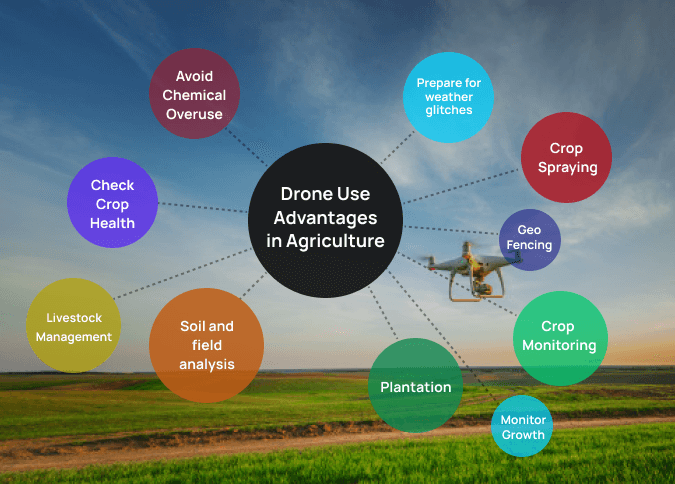
Soil and field analysis
For efficient field planning, agricultural drones can be used for soil and field analysis. They can be used to mount sensors to evaluate moisture content in the soil, terrain conditions, soil conditions, soil erosion, nutrients content, and fertility of the soil.
Crop monitoring
Crop surveillance is the supervision of crop progress from the time seeds are sown to the time for harvest. This includes providing fertilizers at the right time, checking for pest attack, and monitoring the effect of weather conditions. Crop surveillance is the only way that a farmer can ensure a timely harvest, especially when dealing with seasonal crops.
Any errors at this stage can result in crop failure. Crop surveillance helps in understanding and planning for the next farming season. Drones can help in effective crop surveillance by inspecting the field with infrared cameras and based on their real-time information, farmers can take active measures to improve the condition of plants in the field.
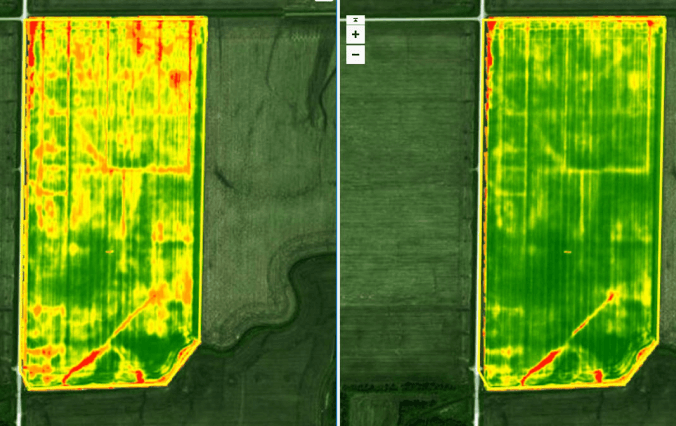
Plantation
Drones can help in planting trees and crops, which was done by farmers before. This technology will not only save labor but also help in saving fuels. Soon, it is expected that budget-friendly drones will be used instead of huge tractors, as they emit harmful gases and pollute the environment in the process.
Livestock management
Drones can be used to monitor and manage huge livestock as their sensors have high-resolution infrared cameras, which can detect a sick animal and swiftly take actions accordingly. So, the impact of drones on precision dairy farming is soon to become a new normal.
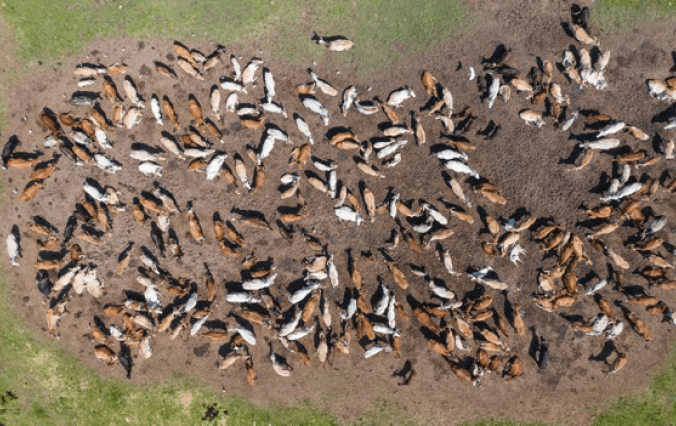
Crop spraying
Agri-drones can be used to spray chemicals as they have reservoirs, which can be filled with fertilizers and pesticides for spraying on crops in very little time, as compared to traditional methods. Thus, drone technology can usher in a new era for precision agriculture.
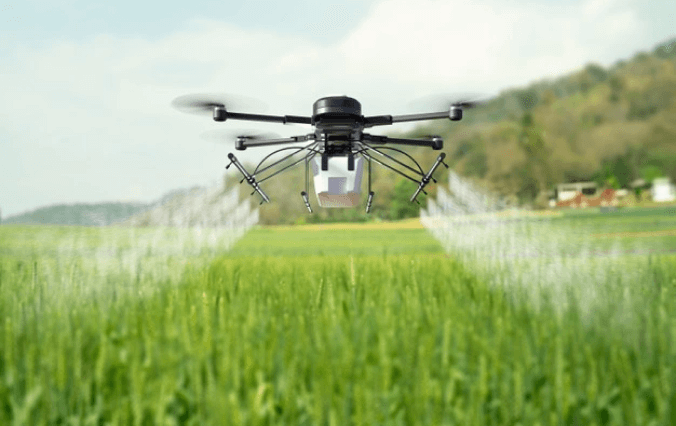
Check crop health
Farming is a large-scale activity that takes place over acres of land. Constant surveys are necessary to monitor the health of the soil and the crop that has been planted. Manually, this may take days, and even then, there is space for human error. Drones can do the same job in a matter of hours. With infrared mapping, drones can gather information about both the health of the soil and the crop.
Avoid overuse of chemicals
Drones can prove to be especially effective in reducing the overuse of pesticides, insecticides, and other chemicals. These chemicals indeed help to protect the crop. But, their overuse can prove to be detrimental. Drones can detect minute signs of pest attacks, and provide accurate data regarding the degree and range of the attack. This can help farmers calculate the required amount of chemicals to be used that would only protect the crops rather than harming them.
Prepare for weather glitches
Weather conditions can prove to be a farmer’s best friend and worst enemy. Since these cannot be accurately predicted, it becomes extremely difficult to prepare for any shift in patterns. Drones can be used to detect upcoming weather conditions. Storm drones are already being used to make better predictions. And this information can be used by farmers to be better prepared. Advance notice of storms or lack of rain can be used to plan the crop to be planted that would be best suited to the season, and how to take care of planted crops at a later stage
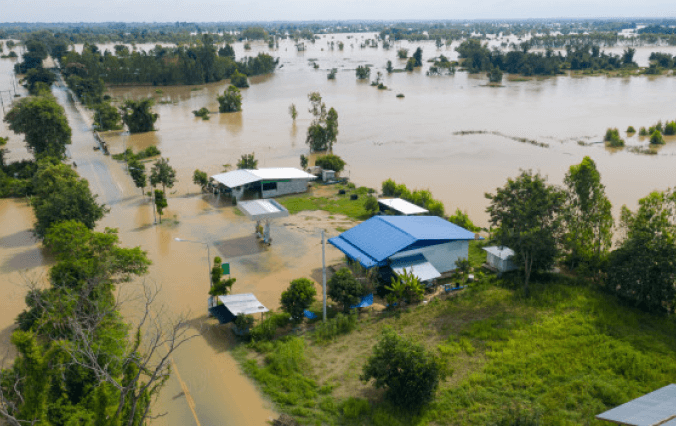
Monitor growth
Even when everything is going according to plan, crops need to be surveyed and monitored to ensure that the right amount of yield will be available at the time of harvest. It is also important for future planning, whether it is about determining the right price for the open market, or harvesting cyclical crops. Drones can provide accurate data about every stage of crop growth, and report any variations before they become a crisis. Multispectral images can also provide accurate information about subtle differences between healthy and unhealthy crops that may be missed by the naked eye. For example, stressed crops will reflect less near-infrared light as compared to healthy crops. This difference cannot be detected by the human eye always. But drones can provide this information in the early stages
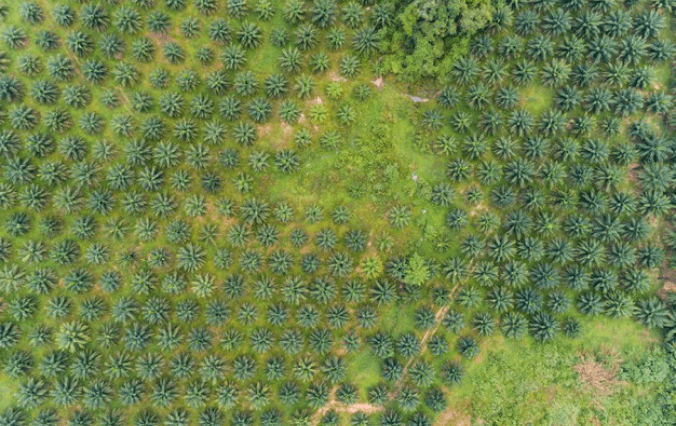
Geofencing
The thermal cameras installed over drones can easily detect animals or human beings. So, drones can guard the fields from external damage caused by animals, especially at night.
Benefits of agri-drones
- Security
The drones are operated by trained drone pilots. So, there are no chances of their misuse. - High efficiency
Drones do not have any operational delays and can work double the speed of human labor. - Water-saving
In comparison to traditional spraying methods, agricultural drones use ultra-low volume (ULV) spraying technology, thus saving more water. - Low cost and easy to maintain
Agri drones are sturdy, low in cost, and require minimum maintenance. Some of the key features include a detachable container, low-cost frame, precise spraying of pesticides.
Limitations of agri drones
- Connectivity issue
Often, online coverage is unavailable in rural areas. Under such circumstances, a farmer needs to invest in internet connectivity, which can turn into a recurring expense. - Weather dependent
Drones do not have any operational delays and can work double the speed of human labor. - Weather dependent
Drones are heavily dependent on good weather conditions. Under rainy or windy weather conditions, it is not advisable to fly drones. - Knowledge and Skill
Using new technology is a welcoming change but using it daily requires the right skillset and adequate knowledge. An average farmer may struggle to understand drone functions. Either he must acquire the knowledge or remain dependent on an experienced person.
How to buy an agricultural drone in India?
Various Indian drone manufacturers are making drones for agricultural purposes. On TropoGo's SkyStore, many agricultural drone models along with specifications are added for viewing and making a purchase decision.
Wrapping Up
Looking further into the future, drone technology is going to change the agriculture sector. Many Indian startups are also showing interest in the industry and aiming to invest in low-cost drones, which can help farmers and simultaneously create employment opportunities for the rural youth and enhance the knowledge of farmers as well.
However, the industry needs mature reforms, keeping in mind the growing population, the needs of the farmers, operational policies, and the shrinking farmlands. Moreover, trained pilots are needed to take forward the still untapped drone market. Our farmers and drone operators are the harbingers of change. Overall, it would be interesting to see how things go ahead, and how useful the applications of drones turn out to be in the long run.
